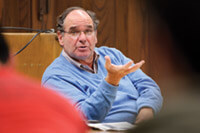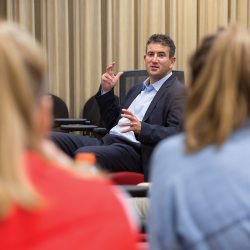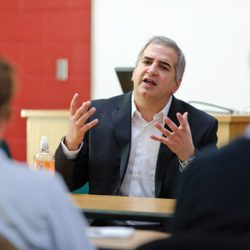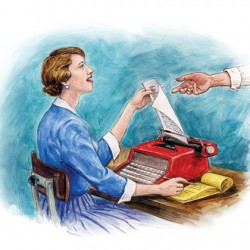From Press to Professor
Longtime sports journalist brings an authentic voice to his classroom.

Shapiro leads a class discussion, delving into firsthand experience to tell students about the evolution of sports journalism. Photo: Jeff Miller
If it happened in sports in the last forty years, chances are Leonard Shapiro ’68 was there to cover the story.
When the U.S. Olympic hockey team beat the Soviet Union in the “Miracle on Ice” at the 1980 games in Lake Placid, Shapiro was among a small group of reporters who chased after Mike Eruzione, who had scored the winning goal, in the parking lot outside the arena to snare a quote before deadline. When Howard Cosell made what seemed to be a racist comment during a football game, Shapiro was there to ask Cosell about it, at the expense of his relationship with the legendary sportscaster. And for more than thirty straight years, when the Super Bowl’s Lombardi Trophy was awarded, Shapiro saw the moment in person.
“We’re talking about somebody who not only saw the birth of modern sports coverage, but participated in it and is a major figure in it,” says Robert Schwoch ’88, lecturer and undergraduate adviser in the School of Journalism & Mass Communication. Shapiro returned to the school this spring to teach the sports journalism class he first taught in spring 2008.
Shapiro’s first job out of UW–Madison was high school sports reporter for the Washington Post. He went on to cover the National Football League, professional golf, the Olympics, and hundreds of other events as a reporter, columnist, and editor for the Post, producing more than 7,400 bylines between 1969 and 2010. During those years, Shapiro observed the evolution of sports — and sports journalism — at all levels.
Money has had a significant influence on athletics, he says. When he started covering the Washington Redskins in the early 1970s, the average salary was about $40,000.
“Now that’s tipping money for most of these guys,” he says. “Money always drives professional sports, but a lot of those guys did play for the love of the game, and it seemed a lot less complicated. And from a journalist’s point of view, the access was so much better.”
Covering sports has changed along the way, too. While Shapiro used to hope that his stories would hold up until his late-evening deadline — praying that he wouldn’t get scooped by his afternoon competitor — sports reporters now compete by the second on Twitter and blogs.
“When do they have time to do the reporting?” Shapiro asks. “I don’t think a lot of papers are breaking the kind of stories they used to, because we had the time to do it.”
During one of Shapiro’s class meetings in the heart of college basketball season, the students’ discussion turned to the NCAA’s decisions about broadcasting this year’s games. Shapiro then moved the talk to the history behind the television coverage of the tournament, which turned that previously minor event into a national pastime — something he observed as a sports broadcasting reporter.
“Not only does he teach a good course, but he really takes the students under his wing outside the class with office hours and making calls on their behalf to his connections in the sports world,” Schwoch says.
Shapiro says he relishes the give-and-take discussion on sports events and issues in the news.
“It’s a very alive kind of atmosphere, as opposed to reading out of a textbook,” he says.
Published in the Summer 2011 issue



Comments
Janice Moulton April 10, 2012
Congratulations on a long and successful career Lenny!! Who would think you would end up back where we all started!! I’ve enjoyed reading the articles about you.
Jay iams October 9, 2024
It’s interesting to see Lenny Shapiro now. I first met him at the Sigma Chi house when we were students at the University of WISCONSIN. I’ve followed his work at the Washington Post intermittently, but am happy to see his success. I’ve googled him and others from the Sig House (Lance Primis, John Scully, Scott Ideson, Jim Gerlach, and others). I’m a retired professor at Ohio State’s medical school. Congratulations, Len on a very successful career!
Jay Iams MD.
Terry Turner May 11, 2025
Hey Lennie!
Finally tried to track you down and have no idea if you will even see this post. If you do read this, get in touch with your old UW and Wisconsin State Journal alumni buddy, a legendary Ohio State graduate, a shout out.